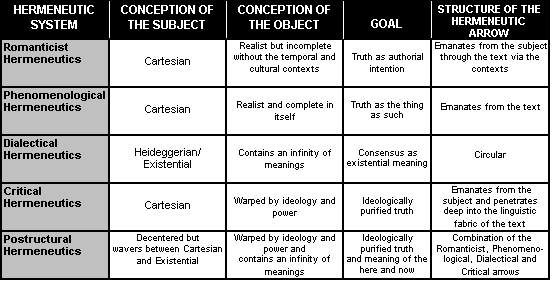 | Vol. 1 No. 1 2001 |
INTRODUCTION TO HERMENEUTICS
F.P.A. Demeterio III
Hermeneutics is derived from the Greek word ermhneuein (hermeneuein), meaning to interpret, and its derivative ermhneia (hermeneia) meaning interpretation. It has a linguistic relationship with Hermes, the swift footed messenger of the Olympian gods, who necessarily had to master the language of the gods, understand and interpret what these immortal beings have in mind, and translate and articulate their intention to the mortal beings. The main reason why hermeneutics seemed to be a very complicated idea is that it has indeed become complex due to the inter-twining of its multiple layers of meanings and concerns. The first step, therefore, in understanding it is to untangle its multiple layers. In its barest sense, hermeneutics can be understood as a theory, methodology and praxis of interpretation that is geared towards the recapturing of meaning of a text, or a text-analogue, that is temporally or culturally distant, or obscured by ideology and false consciousness. Hermeneutics presupposes that texts and text-analogues that are distant in time and culture, or that are blanketed by ideology and false consciousness, would necessarily appear chaotic, incomplete, contradictory and distorted, and that they need to be systematically interpreted to unveil their underlying coherence or sense. As this working definition suggests, hermeneutics has three different layers of meanings and concerns: namely, 1) theory, which is concerned about the epistemological validity and possibility of interpretation; 2) methodology, which is concerned about the formulation of reliable systems of interpretation; and 3) praxis, which is concerned about the actual process of interpreting specific texts.
Hermeneutics, as a praxis of interpretation, emerged very early in the history of civilizations. The great cultures of the antiquity generally had their share of sacred literature that need to be interpreted and re-interpreted by their priestly and royal classes. Thus, hermeneutics had been practiced by ancient people long before philosophy ever though of it as a discipline belonging to its own province. In late antiquity, the Greeks, the Jews and the Christians had been reading and re-reading their vital texts, namely the Homeric epics, the Torah, Tamud and Midrashim, and the Holy Bible, respectively. In the process of their textual labor, these people revised their own idiosyncratic sets of rules for doing interpretation: thus, hermeneutics, as methodology of interpretation, started to evolve from hermeneutics, as praxis of interpretation.
The full development of hermeneutics, as methodology of interpretation, however, happened some more centuries later during the Renaissance period. This development was triggered by a heightened need for hermeneutic praxis that transformed the once purely practical operation into a self-conscious procedure. This heightened need for praxis in return had been catalyzed by two landmark historical phenomena: the protestant reformation and the renaissance's fascination for classical Greek and Roman texts. The protestant reformation had spawned a whole process of debate regarding the christian's relationship with the sacred scriptures. Whereas the catholic church re-asserted, during 1546 the Council of Trent, its age-old position that it is its own authority which is the ultimate norm of interpreting the Holy Bible, the protestants insisted on the principles of perspicuity-the need for a keenness of the interpreter's discernment-and self sufficiency of the sacred scriptures. Freed from the blanketing dogma of the catholic church, the protestant theologians and scripturists, led by Matthias Flacius Illyricus (1520-1575), have to rely on more self-conscious hermeneutic systems. The renaissance's fascination with the classical Greek and Roman texts, as the second catalyst, had already generated a whole arsenal of interpretive methodologies, collectively known as Ars Critica, that are useful in establishing the authenticity of the texts as well as in reconstructing the text's most original and correct version. Side by side with this purely humanist concern, renaissance jurists were also struggling to re-interpret the Roman Law, specifically, the Justinian Code of AD 533. Hermeneutics as methodology of interpretation, therefore, did not only fully develop during the renaissance period, it proliferated into a collection of contradicting, incoherent and confusing systems.
From the chaotic presence of hermeneutic systems, as methodologies of interpretation, there appeared a need for a more critical and foundational evaluation of interpretation itself, an epistemology into its validity and possibility. It was Friedrich Daniel Ernst Schleiermacher (1768-1834), a German protestant theologian and philologist, who initiated philosophy's focusing on the problems of interpretation and the need for a unified systematic method of hermeneutics. Thus, hermeneutics, as a theory, or epistemology, of interpretation materialized.
Placed in a crucible of intense philosophical analysis and further theorization, hermeneutics emerged as a more powerful system suitable not only for religion, and humanism, but also for the steadily growing social sciences. The contagion of hermeneutics from the world of religious and humanist textuality to the social sciences' sphere of human action, behavior and culture had been facilitated by the expansion of the meaning of textuality itself. What was traditionally understood as something that refers only to things that are or can be written has been stretched to cover almost anything that has something to do with man and culture. Today, not only documents, literary texts and scriptures can be called texts, but also symbols, rituals, practices and customs, myths, structures of power, kinship and social set-ups, and many more besides. The evolution of hermeneutics, therefore, from pure unreflective praxis that is solely concerned with religious themes to a highly systematic and reflective praxis that can be applied to any text or text-analogue, can be graphically represented by the following chart.
The fact that hermeneutics evolved from praxis into praxis demonstrates that it is its praxis component which is its most important layer of meaning, its ultimate aim and its reason for existence. Take away praxis from the picture, then theory and methodology theory would not make any sense at all. But the fact that it also evolved into its present status of being highly systematic and reflective scientific praxis dictates that before the modern-day praxis can ever commence a thorough knowledge of theory and methodology is necessary.
Even though Schleiermacher attempted to unify the pre-existing diverse hermeneutic systems, this diversity persisted through the present times. However, today's immense number of hermeneutic systems need not be seen as a chaotic mass, nor a dense cognitive forest, that are enough to discourage the neophyte from exploring further. These systems can be easily categorized into just five groups of hermeneutic systems: namely, 1) romanticist hermeneutics, 2) phenomenological hermeneutics, 3) dialectical hermeneutics, 4) critical hermeneutics, and 5) post-structural hermeneutics. This categorization, though admittedly a didactic attempt to organize diversity for the sake of presentation to the neophyte, is nevertheless not something that is purely arbitrary. Rather, our categorization of the diverse hermeneutic systems into just five groups is specified by the variations of the structural components of interpretation itself, of which there are three: namely, 1) the interpreter, or the subject; 2) the thing being interpreted, or the object, which is either a text or a text analogue; and 3) the goal of the interpretive act, which is either truth or meaning.
How a given hermeneutic system preconceives the subject, the object and its goal will determine not only its categorization to any of the aforementioned five systems, but also the structure of this given hermeneutic system itself. Hermeneutic systems are structured in accordance to their idiosyncratic notions of subjectivity, textuality, and truth/meaning. In the following sections we are going to take some cursory look on how the three components of interpretation actually give structure to each of the five groups of hermeneutic systems.
Schleiermacher and his follower Wilhelm Dilthey (1833-1911) are the main proponents of romanticist hermeneutics.i As theorists of the 19th and the 20th centuries, both of them were heirs to a very dominant philosophy of the subject initiated by the French scientist, mathematician, and founder of modern philosophy Rene Descartes (1596-1650). With his famous statement Cogito, ergo sum, Descartes painted a subject who, though prone to commit cognitive errors and conceptual distortions, is nonetheless fully self-conscious and capable of attaining objective knowledge through a regimen of philosophical, scientific and mathematical methodologies. This Cartesian subject is the same subject that is presupposed by romanticist hermeneutics. As a biblical scholar and philologist, Schleiermacher had a first hand experience of the recurrent vagueness of texts, prompting romanticist hermeneutics to conceptualize textuality as some sort of a floating signifier that is incomplete without its temporal and cultural contexts.ii reformation biblical scholar, Schleiermacher intended that the goal of romanticist hermeneutics is to recapture the truth of the text, which is defined in terms of the original authorial intent. Graphically, we may represent the structural components of romanticist hermeneutics as follows.
Romanticist hermeneutics' idiosyncratic notions of the subjectivity, textuality and truth had structured its own system itself. The process of interpretation, represented by the arrows, has to emanate from the interpreter through the text, and from the interpreter through the text via the historical and cultural context, in order to recapture the original authorial intention. The system, as a whole, has to be rigorous with its textual, historical and cultural methodologies because of its preconception of a single and unitary truth determined by a single and unitary authorial intent.
Edmund Husserl (1859-1938), the founder of the phenomenological movement, like Descartes, was also a mathematician and philosopher.iii Though he shared the same skepticism about scientific method that can be traced back as far as the romantic movement, he nonetheless believed that despite the human cognitive frailty, the human subject remains fully self-conscious and capable of attaining reliable knowledge through a more systematic approach. Husserl's philosophy of the subject remains Cartesian. Like the romanticist hermeneutics, phenomenological hermeneutics also assumes that in order for the object to be fully interpreted, a proper context, or a mental frame is needed. But instead of considering the extraneous historical and cultural contexts, phenomenological hermeneutics argued that the text reflects its own mental frame. Husserl stated his dictum Zu den Sachen selbst! ("to the things themselves"), because he considered objects as complete in themselves. To interpret a text, therefore, means to methodically isolate it from all extraneous things including the subject's biases and allow it to communicate its meaning to the subject. The goal of phenomenological hermeneutics is to capture to truth of the text as it is. Graphically, we may represent the structural components of phenomenological hermeneutics as follows.
Thus, phenomenological hermeneutics' idiosyncratic notions of the subjectivity, textuality and truth had structured its own system itself. The process of interpretation, again represented by the arrows, has to emanate from the text through the interpreter to come up with the truth of the text as such. From the phenomenological point of view, interpretation is not something that a reader does, but something that happens to him. Though this hermeneutic system lacked the rigorous textual, historical and cultural methodologies that characterized romantic hermeneutics, phenomenological system as a whole has to allocate painstaking and meticulous attention to the subjective bracketing off of biases, as well as detailed observation of and reflection on the text in order to capture the truth of text as it is.
If both romanticist and phenomenological hermeneutics took for granted the Cartesian subject, dialectical hermeneutics is founded on, and in fact contributed to the emergence of, a new philosophy of the subject.iv Martin Heidegger (1889-1976), a German philologist, philosopher, and the main proponent of dialectical hermeneutics, though a student and follower of Husserl, questioned the possibility of the reader to actually prevent his biases and presuppositions to color his understanding and interpretation. Heidegger constructed a new subject whose mind and being are totally immersed in the subject's life-world, such that understanding and interpretation would always proceed from the perspective of the subject's life-world. The Heideggerian subject is a subject that is formed by the biases and presuppositions of his/her life-world making him/her incapable of attaining full self-consciousness and objective knowledge. Thus, instead of hypocritically scrapping these biases and presuppositions, dialectical hermeneutics argued for a better use of these cognitive baggage by using them as premises in conversing with texts and objects. By assailing the Cartesian subject, Heidegger also assailed the metaphysics of realism that served as the cornerstone for the Cartesian, romanticist and phenomenological philosophies of the object. A new philosophy of the object is needed. For dialectical hermeneutics, an object, or text, can contain an infinity of meanings. Hence, unlike the romanticist and the phenomenological hermeneutics, dialectical hermeneutics is not interested in capturing a single and unified meaning, but instead in an existential meaning, the meaning of the here and now. Graphically, we may represent the structural components of dialectical hermeneutics as follows.
Hence, dialectical hermeneutics' idiosyncratic notions of the subjectivity, textuality and truth had structured its own system itself. The process of interpretation, again represented by the arrows, has to be circular, symbolizing the conversation between the world of biases and presuppositions of the reader and the world of biases and presuppositions of the text. More specifically, the reader has to project first his own biases and presuppositions unto the text, and allows the text to project its own biases and presuppositions in return to him/her. This circular process may go on and on, until a consensus is reached. This consensus constitutes the existential meaning of the text. It is a fact that this hermeneutic system lacked the rigorous textual, historical and cultural methodologies that characterized romantic hermeneutics, as well as the detailed observation and reflection that characterized phenomenological hermeneutics. These methodologies, however, are supplanted by a heightened attention to the radical differences between the subject's and the object's life-worlds, and sincere conviction to listen and to dialogue.
The Heideggerian existential subject did not emerge unchallenged. The critical theorists from the Institut fur Sozialforschung (founded, 1923), otherwise known as the Frankfurt School, a center known for its strategic combination of Marxist style philosophical investigation with the emerging methodologies of the social sciences, remained faithful to the Cartesian subject: the fully self-conscious mind who despite its frailty is capable of attaining reliable knowledge through a systematic approach.v Yet, even though basically Cartesian in its conception of the subject, the theorists of critical hermeneutics have a radically new philosophy of the object that is very different from the realist metaphysics of romanticist and phenomenological hermeneutics, as well as from the existential object of dialectical hermeneutics. The new philosophy of the object is founded on the thoughts of the German philosopher and economist Karl Marx (1818-1883), the German philosopher and philologist Friedrich Wilhelm Nietzsche (1844-1900), and the Austrian physician and founder of psychoanalysis Sigmund Freud (1856-1939). These theorists demonstrated that textuality can be infiltrated with power and forces that are formerly considered extraneous to it and practically innocuous. Specifically, Marx argued that textuality can be warped by capitalist and class-based ideologies; Nietzsche, by cultural norms; and Freud, by the unconscious. These extraneous powers and forces are capable of penetrating deep into the text, by weaving into its linguistic fabric. Thus, even without the cultural and temporal distances that made romanticist hermeneutics anxious, or even without the differences of life-worlds that bothered both phenomenological and dialectical hermeneutics, there is no guarantee for the reader to be brought side by side with the truth/meaning of a text, because textuality can be veiled by ideology and false consciousness. The goal of this hermeneutic system is to diagnose the hidden pathology of texts and to free them from their ideological distortions. Graphically, we may represent the structural components of critical hermeneutics as follows.
Again, we have seen how the idiosyncratic notions of subjectivity, textuality and truth had structured the critical system of interpretation. The process of interpretation, represented by the arrows, has to emanate from the reader from various points penetrating deeply into the linguistic fabric of textuality, in order to establish truth which is perceived as freedom from ideological distortions. Since ideological infiltration supposedly happens in a particular point in time and space, it is not unusual for critical theorists to employ the historical and cultural methodologies of the romanticist hermeneutics as auxiliary tools.
The radically new philosophy of the object generated by the path-breaking thoughts of Marx, Nietzsche and Freud, were pursued further by the post-structuralists in the sphere of the philosophy of the subject, thereby giving birth to the post-modern subject.vi For the post-structuralists, the subject has lost its primacy that had been taken for granted by the previous philosophical systems, it is now decentered, and is presently considered a mere intersection of point of the various socio-economic and cultural forces that shape the human individual. This is the philosophy of the subject that post-structuralism is explicitly espousing. But to what extent do the post-structuralist theorists actually upholding such notion of subjectivity. They are a little ambivalent here. A human person, as an other, or as a text, is certainly viewed as a decentered person by the postructuralist. But the human person, as the self, or as the reader, or as the post-structuralist critic, is viewed in a slightly different light. In the bottom-line, the post-structuralist philosophy of the subject wavers between the Cartesian and the existential paradigms of subjectivity. As heirs of the philosophies of suspicion of Marx, Nietzsche and Freud, postructuralist hermeneutics also adheres to a philosophy of the object that is similar to that of the critical hermeneutics: texts are warped by power and ideology. In addition to this critical conception of the object, post-structuralists also adhere to the idea of dialectical hermeneutics that texts may contain an infinity of meaning. They see texts as a web of other texts, whose meanings are determined by the readers instead of the original authorial intention. Hence, like their philosophy of the subject, the post-structuralist philosophy of the object, or of textuality, also wavers between the critical and the dialectical ideas of objectivity or textuality. If their philosophies of the subject and the object waver between two paradigms, their conception of the goal of interpretation would also be two-fold. First, like critical hermeneutics, post-structural hermeneutics aims to diagnose the hidden pathology of texts and to free them from their ideological distortions. Second, like dialectical hermeneutics, post-structural hermeneutics is not interested in capturing a single and unified meaning, but instead in an existential meaning, the meaning of the here and now. Graphically, we may represent the structural components of post-structural hermeneutics as follows.
The distinctive ideas of subjectivity, textuality and truth/meaning had structured the post-structuralist system of interpretation. Post-structural hermeneutics, being at the receiving end of the developments in hermeneutic philosophy, side by side with its inherent suspicion for grand and unified methodological theorizing, is so fluid and dynamic to adapt several interpretive methodologies from the past. Thus, as graphically shown above, the process of interpretation emanated from a number of points representing the post-structuralist debt to the preceding hermeneutic systems. Above all, post-structuralist hermeneutics does not only explore the parameters of textuality, but also the institutional, social, and political structures that define the relationship between truth/meaning and power. Feminist and post-colonial criticism, and several other post-modern interpretive theories are the instances of this type of hermeneutic system.
Hence, we have seen that even with the immense diversity of hermeneutic systems, we need not plow through a confusing mass of chaotic materials, nor explore through a dense cognitive forest, for we have strategically organized these systems into just five groups. As we have mentioned, our strategic schematization is nothing purely didactic but is governed by the variations of the three structural components of the diverse hermeneutic systems themselves. The following table presents a concise comparison of the different preconceptions of subjectivity, textuality, and truth/meaning of each of the aforementioned hermeneutic systems, and how these preconceptions have determined the structure of the hermeneutic arrows.
Though our strategic approach is nothing arbitrary, admittedly it is reductionist in nature. We should expect therefore to see fuller detail and further variations when we explore the specific hermeneutic systems within each of the five groups.
After going through the different layers of hermeneutic concerns, and after having an overview of the different groups of hermeneutic systems, two crucial questions may confront us at this point. First, among the three different layers of hermeneutic concerns-namely, theory, methodology, and praxis-which one is the most important? Second, among the five different groups of hermeneutic systems, which one is the most powerful interpretive tool?
For the first question, as it is already stated above, the fact that hermeneutics evolved from pure praxis to highly reflective praxis is enough proof that it is the praxis component of hermeneutics which is its most important layer. There is hermeneutic theory, and there is hermeneutic methodology, because there is a need for hermeneutic praxis in the first place. But, again as it is already stated above, the fact that hermeneutics evolved into its present status of being highly systematic and reflective scientific praxis dictates that before the modern-day praxis can ever commence a thorough knowledge of theory and methodology is necessary. In a similar flow of reasoning, this introductory essay to hermeneutics is ultimately intended to encourage the praxis of hermeneutics. But the fact that this essay is an introductory material to hermeneutics as a whole dictates that it focus more on the theoretical and methodological concerns of hermeneutics. The praxis of hermeneutics will only happen when a subject, having a thoroughly functional knowledge of the theory and methodology of hermeneutics, applies his/her knowledge in the actual interpretation of specific texts.
For the second question, among the five groups of hermeneutic systems, there is really no best system. Each of the five systems has its own advantages and disadvantages. The question "which is the best system?" can be answered only in relation to the specific hermeneutic task at hand. This means that we have to settle first the question "what is it that I want to do?" and looking for the most appropriate hermeneutic system will be an easier thing to do. There is no best hermeneutic system, there are only appropriate or suitable hermeneutic systems.
ii Temporal context refers to the historical circumstances surrounding the text, and cultural context refers to the cultural circumstances surrounding the text. In general, the wider the distance between the reader's present moment and the text's temporal context, the more laborious interpretation becomes, and the more necessary hermeneutics grows. A present-day Filipino history student, for instance, will find it more difficult to read a memoir a 19th century Illustrado than to read the diary of his Manilena friend, for the reason that there is a wider temporal distance between the student and the 19th century memoir compared to the temporal distance between the student and his friend's diary. On the other hand, the wider the distance between cultural background of the reader and the text's cultural context, again, the more laborious interpretation becomes, and the more necessary hermeneutics grows. Because of differences in cultural contexts, our reading of an epic belonging to an African tribe would be difficult compared to our reading of a modern Filipino novel.
iii The term phenomenology is derived from the word phenomenon meaning appearance, which in the philosophy of Immanuel Kant (1724-1894) was deployed to refer to how something appears in the subject's consciousness, and in contradistinction to noumenon, the thing-in-itself.
iv The term dialectical is based on a Greek root that means conversation, and debate.
v The term critical is based on a Greek root that means judge, or to pass judgement.
vi The term post-structuralism refers to a philosophical and cultural movement which is both an offshoot and antithesis to structuralism as advocated by Ferdinand de Saussure and Claude Levi-Strauss.
THE IDEA OF HERMENEUTICS 
THE DIVERSE HERMENEUTIC SYSTEMS 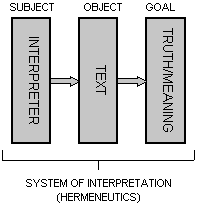
Romanticist Hermeneutics 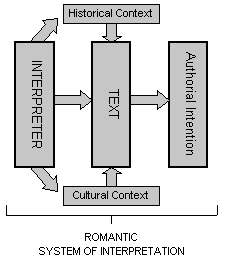
Phenomenological Hermeneutics 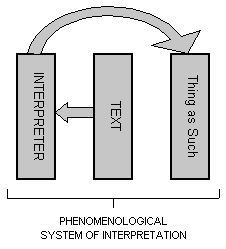
Dialectical Hermeneutics 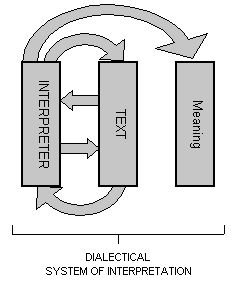
Critical Hermeneutics 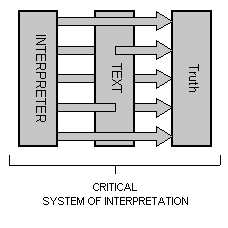
Post-Structural Hermeneutics 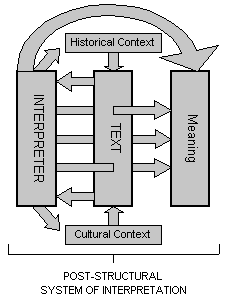
Retrospect on the Organized Diversity of Hermeneutic Systems 